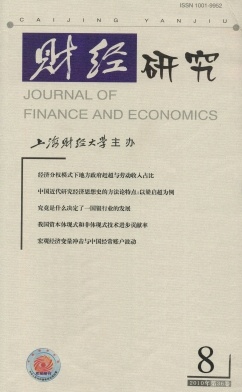宏观经济变量冲击与中国经常账户波动
财经研究 2010 年 第 36 卷第 08 期, 页码:101 - 111
摘要
参考文献
摘要
文章考察了近些年来中国经常账户出现的持续顺差现象。文章在参考国外已有相关研究文献的基础上,构建了一个以中国经常账户实际值按与其标准误偏离程度排序作为离散因变量、以八个宏观经济变量和三个时期虚拟变量为解释变量的排序Probit模型。通过计量分析和计算,我们发现仅有两个宏观经济变量的冲击(产出缺口和滞后的净外部资产头寸增量)对中国经常账户顺差规模波动排序具有显著的解释能力,二者均为正向作用,且后者的影响力大于前者;另外,两个时期虚拟变量(中国加入WTO和2005年7月"新汇改")在回归分析中也表现出较强的解释力。最后,文章据此提出了一些政策调整建议。
关键词
②参见余永定、覃东海(2006)、余永定(2007)、卢峰(2006)、贺力平(2007)等人的相关研究。
[1]贺力平.人民币汇率与近年来中国经常账户顺差[J].金融研究,2008,(3):13-27.
[2]卢峰.中国国际收支双顺差现象研究:对中国外汇储备突破万亿美元的理论思考[J].世界经济,2006,(11):3-10.
[3]余永定,覃东海.中国的双顺差:性质、根源和解决办法[J].世界经济,2006,(3):31-41.
[4]余永定.全球不平衡条件下中国经济增长模式的调整[J].国际经济评论,2007,(1-2):5-11.
[5]Amelia Santos-Paulino,AP Thirl wall.Thei mpact of tradeliberalisation on exports,i m-ports and the balance of payments of developing countries[J].The Economic Journal,2004,114:50-72.
[6]Bernardina Algieri,Thierry Bracke.Patterns of current account adjust ment:Insightsfrompast experience[R].European Central Bank,Working Paper Series,No.762,2007.
[7]Dominick Salvatore.Twin deficits in the G-7 countries and global structural i mbalances[J].Journal of Policy Modeling,2006,28:701-771.
[8]Guy Debelle,Gabriele Galati.Current account adjust ment and capital flows[R].BISWorking Papers,No.169,2005.
[9]Freund C.Current account adjust ment inindustrialized countries[J].Journal of Interna-tional Money and Finance,2005,8:1278-1298.
[10]Joseph W Gruber,Steven B Kamin.Explaining the global pattern of current accounti mbalances[J].Journal of International Money and Finance,2007,26:500-522.
[11]Milesi-Ferretti G M,A Razin.Current account reversals and currency crises:EmpiricalRegularities[A].P Krugman.Currency crises[C].University of Chicago Press,Chica-go,United States,2000.
[12]Sebastian Edwards.On current account surpluses and the correction of global i mbal-ances[R].Tenth Annual Conference of the Central Bank of Chile on Current Accountand External Financing,Central Bank of Chile,2006.
[1]贺力平.人民币汇率与近年来中国经常账户顺差[J].金融研究,2008,(3):13-27.
[2]卢峰.中国国际收支双顺差现象研究:对中国外汇储备突破万亿美元的理论思考[J].世界经济,2006,(11):3-10.
[3]余永定,覃东海.中国的双顺差:性质、根源和解决办法[J].世界经济,2006,(3):31-41.
[4]余永定.全球不平衡条件下中国经济增长模式的调整[J].国际经济评论,2007,(1-2):5-11.
[5]Amelia Santos-Paulino,AP Thirl wall.Thei mpact of tradeliberalisation on exports,i m-ports and the balance of payments of developing countries[J].The Economic Journal,2004,114:50-72.
[6]Bernardina Algieri,Thierry Bracke.Patterns of current account adjust ment:Insightsfrompast experience[R].European Central Bank,Working Paper Series,No.762,2007.
[7]Dominick Salvatore.Twin deficits in the G-7 countries and global structural i mbalances[J].Journal of Policy Modeling,2006,28:701-771.
[8]Guy Debelle,Gabriele Galati.Current account adjust ment and capital flows[R].BISWorking Papers,No.169,2005.
[9]Freund C.Current account adjust ment inindustrialized countries[J].Journal of Interna-tional Money and Finance,2005,8:1278-1298.
[10]Joseph W Gruber,Steven B Kamin.Explaining the global pattern of current accounti mbalances[J].Journal of International Money and Finance,2007,26:500-522.
[11]Milesi-Ferretti G M,A Razin.Current account reversals and currency crises:EmpiricalRegularities[A].P Krugman.Currency crises[C].University of Chicago Press,Chica-go,United States,2000.
[12]Sebastian Edwards.On current account surpluses and the correction of global i mbal-ances[R].Tenth Annual Conference of the Central Bank of Chile on Current Accountand External Financing,Central Bank of Chile,2006.
引用本文
焦武. 宏观经济变量冲击与中国经常账户波动[J]. 财经研究, 2010, 36(8): 101–111.
导出参考文献,格式为:





 5464
5464  2487
2487

